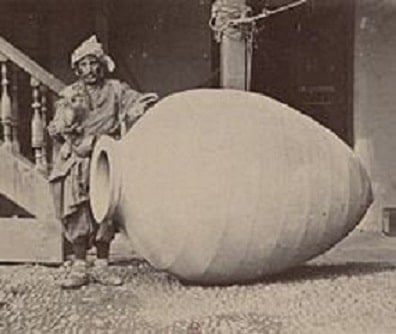They all visited the Republic of Georgia and were so impressed with the distinctive wines (among other unique attributes) that when they returned home, they wrote about them.
Georgia Oozes History
If you live in Georgia, you are most likely to call your country Sakartvelo. Some research suggests the name “Georgia” originated in the Middle Ages when Christian crusaders passed through the region on their way to the Holy Land. At the time it was part of the Persian Empire and locals were known as Guri who were devoted to St. George a patron saint in the Middle Ages acknowledged by England, Catalonia, Venice, Genoa, and Portugal because he was the personification of the ideals of Christian chivalry. The Crusaders made the connection and named the country Georgia.
Early Georgian winemaking was documented in a medieval hymn, “Thou Art a Vineyard” that was dedicated by King Demetrius (1093-1156AD) to his new Georgian Kingdom. The hymn begins, “You are a vineyard newly blossomed, young beautiful, growing in Eden.”
Georgian wine was held in great esteem by the Assyrian kings who amended their laws that permitted residents to pay their debts in wine instead of gold.
On the other side of history is Joseph Stalin. He was born in Georgia and gained infamy as a revolutionary in the Russian Empire becoming the political leader of the Soviet Union from 1924 – 1953. Some continue to revere him because he defeated Hitler; however, most view him as a tyrant responsible for the brutal slaughter of his own people.
Location, Location, Location
The highest mountain range in Europe is the Caucasus Mountains, creating the border between Georgia and Russia. The highest peak may be in Russia; however, the second highest peak, Shkara, is in Georgia (17,040 ft) beating Mount Blanc by almost 1312 feet.
Located 600 miles east of the Bosporus, Georgia is located in Asia, bounded by the Black Sea to the west, Russia to the north and northeast, Turkey to the southwest, Armenia to the south, and Azerbaijan to the southeast. The country covers 26,900 sq miles with a population of 3.7 million people. A third of the population lives in Tbilisi – the capital and largest city with 3.7 million inhabitants.
Wine Part of History
Winemaking in Georgia is part of its history as the process started over 8,000 years ago and many consider the Republic to be the “cradle of wine.” Throughout the centuries, Georgia has been invaded, pushing ancient winemakers out of their vineyards. Fortunately, there was a tradition of saving saplings for transitional cultivation which enabled viticulture and winemaking to survive.
Legend states that Saint Nino, the first preacher of Christianity in Georgia, created her cross from grapevine stems and entwined the stems with her own hair. It is also believed that the monks of the Alaverdi monastery contributed to the preservation of the qvevri (aka kvevri and tchuri) method.
Georgia’s wine producers flourished in the Middle Ages, as the eastern Mediterranean region was rocked by the Crusades. As a Christian nation, Georgia was left unscathed by the Crusaders and was able to develop its agriculture and commerce in relative peace. Later, it remained outside of the Ottoman Empire, whose Islamic Sharia law prohibited wine consumption.
Wine production flourished in Georgia until phylloxera and mildew arrived from the Americas in the late 19th Century. The pest devastated almost 150,000 acres (60,700ha) of vineyards.
When Georgia came under Soviet control a few decades later, vineyards were replanted in their thousands to meet expanded demand. However, the late 1980s saw a dramatic about-face in the Soviet Union’s attitude to wine. Mikhail Gorbachev’s aggressive anti-alcohol campaign effectively crippled Georgian wine exports.
The country has enjoyed only brief periods of political stability since it declared independence from the USSR in 1991. Tensions between Georgia and Russia continue today, as evidenced by Russia’s 2006 embargo on Georgian wine imports, which was not lifted until June 2013.
Georgia’a Qvevri Method
Qvevri are large earthenware terracotta clay vessels used for the fermentation, storage, and aging of traditional Georgian wine. The container resembles large, egg-shaped amphorae without handles and can be buried below ground or set into the floors of large wine cellars.
Amphorae are made with handles and qvevri do not have handles, differentiating the functions of each. In ancient Greece and Rome, amphorae were used exclusively for the transportation and storage of edible products such as wine and olive oil and not for wine production.
Qvevri have always been part of the winemaking process and are unsuitable for transport because of their size and, of course, they are buried in the ground.
During the final stages of qvevri construction, the insides of each vessel is covered with beeswax (the pots remain porous and allow some air to pass through during the fermentation); the beeswax helps to waterproof and sterilize the vessel allowing winemaking a more hygienic process and the vessels are easier to clean after each use. Once they are installed underground, when cleaned and maintained correctly, qvevri can be used for centuries.
Initially, the qvevri of ancient Georgia were large enough to accommodate the needs of a family. As demand increased the qvevri were enlarged enabling the production of a higher volume of wine per vessel. As size increased the clay structures became unstable under their own immense weight as well as the buildup of pressure during fermentation. To assist in the stabilization during the process, winemakers started burying qvevri underground. This was a surprisingly smart move for by moving the production underground they discovered the ancient form of refrigeration (temperatures are cooler underground). This enables a longer maceration period for the grapes on fermenting must, which would otherwise cause the wine to spoil above ground. The extended maceration period develops an increase in aroma and flavor profiles in qvevri wines. UNESCO named the qvevri method an intangible Cultural Heritage site in 2013.
The Process
Grapes are partially pressed before they enter the qvevri for fermentation. In some regions, the skins and stems may be included; however, in the colder regions this process is considered undesirable for the wine could develop “green” characteristics.
Fermentation starts after a few days and continues for 2-4 weeks. As a solid mass of skins, stems, or cap develops, it sinks below the surface of fermenting juice. The cap imparts flavors, aromas, and tannins to the grape must. During fermentation, this cap is punched down twice daily to increase its impact on the wine.
When the cap finally falls, the skins and stems are removed for red wines, while whites are left n contact. The next step is to cover the qvevri with stone lids and malolactic fermentation begins. Wines are left to mature for approximately 6 months, during which time lees and solids fall into a section at the base of the vessel where the contact and impact is minimal.
At the end of the process, wine is transferred to a freshly cleaned qvevri or another storage vessel until bottling; sometimes the wine is bottled immediately.
Kvevris hold 10 to 10,000 liters (800 is typical) and enrich the wine with loamy clay. The wine is unsulphurated and produces an orange hue wine that are are slightly oxidative and tannic.
An Assortment of Grapes
Georgia has nearly 50,000 hectares of grapes, with 75 percent planted in white grapes and 25 percent in red grapes. The largest portion of the nation’s vineyards are planted in the Kakheti region of eastern Georgia, the country’s primary winemaking area. The two most prominent grapes are Rkatsiteli (white) and Saperavi (red).
Georgia counts approximately 500 indigenous grape varieties but until very recently, commercial production focused on very few as many were wiped out during Soviet times when the emphasis was based on consolidation and efficiency. Today, around 45 varieties are commercially produced; however, the Georgian government is on a mission to save and reintroduce old grapes and expand options. In summer 2014, the National Wine Agency started to reinvent the wine industry by giving over 7000 plants of “obscure” and indigenous varieties to growers around the country.





